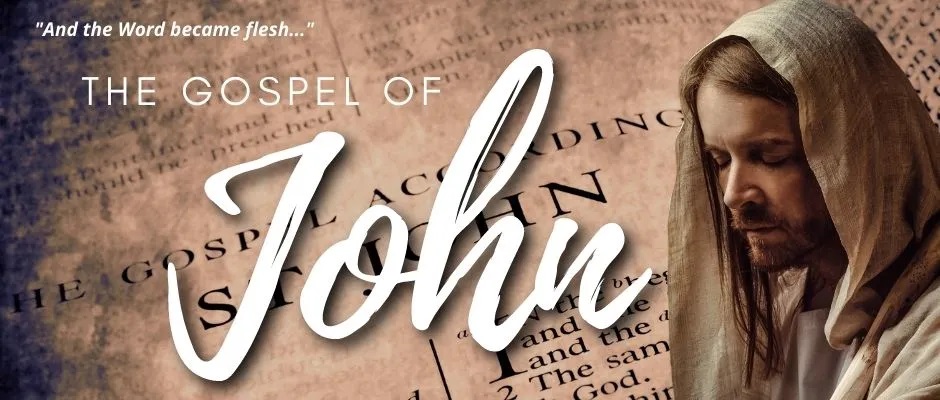The Gospel of John is one of the most profound and theologically rich books of the New Testament. Unlike the Synoptic Gospels (Matthew, Mark, and Luke), John takes a unique approach in presenting Jesus Christ as the Son of God. His Gospel highlights not only the miracles and teachings of Jesus but also His divine nature, eternal existence, and intimate relationship with God the Father.
For those exploring Bible studies, theology, or spiritual growth, this article explores the Gospel of John in detail, focusing on its themes, structure, unique features, and the portrayal of Jesus Christ as the Son of God and Savior of the world.
Introduction to the Gospel of John
The Gospel of John is the fourth book of the New Testament and the last of the four Gospels. Written by John the Apostle, also known as “the disciple whom Jesus loved” (John 13:23), it offers a deeply spiritual and reflective account of the life of Christ.
Understanding the Book of Matthew: Jesus Christ the Messiah
Unlike the other Gospels, which emphasize the chronology of Jesus’ ministry, John emphasizes the identity of Jesus—that He is the eternal Word of God made flesh (John 1:14). The central purpose of the book is stated in John 20:31:
“But these are written that you may believe that Jesus is the Messiah, the Son of God, and that by believing you may have life in His name.”
This makes the Gospel of John not only a historical record but also an evangelistic and theological masterpiece.
Authorship and Historical Context of the Gospel of John
The authorship of the Gospel of John has been a subject of scholarly debate for centuries. Traditionally, it is attributed to John the Apostle, the son of Zebedee, one of Jesus’ closest disciples and part of his inner circle. Early church fathers, such as Irenaeus in the second century, supported this view, noting that John composed the Gospel based on his eyewitness experiences. Patristic evidence from figures like Papias also points to John as the author, emphasizing his role in countering early heresies by affirming Jesus’ divinity. However, modern scholars often question this, suggesting the Gospel may have been written by a community of John’s followers or an anonymous author using Johannine traditions. The text itself does not explicitly name the author, referring instead to “the disciple whom Jesus loved” (John 21:20-24), widely interpreted as John.
The Gospel is dated to around 90-100 AD, likely composed in Ephesus, Asia Minor, after the destruction of the Jerusalem Temple in 70 AD. This late date reflects a context of growing tensions between early Christians and Jewish synagogues, as well as emerging Gnostic influences that separated the spiritual from the physical. John addresses these by emphasizing Jesus’ incarnation—God becoming flesh—to affirm his full divinity and humanity. Written for a mixed audience of Jews and Gentiles, the Gospel aims to strengthen faith amid persecution and doctrinal challenges, stating its purpose clearly: “that you may believe that Jesus is the Messiah, the Son of God, and that by believing you may have life in his name” (John 20:31). In a historical era of Roman dominance and religious pluralism, John’s portrayal of Jesus as the eternal Son offers hope and certainty to believers facing uncertainty.
Structure of the Book of John
The Gospel of John comprises 21 chapters and is often divided into two main sections: the “Book of Signs” (John 1-12) and the “Book of Glory” (John 13-21), framed by a prologue and epilogue.
Understanding the Book of Mark: Jesus Christ the Servant
The prologue (John 1:1-18) introduces Jesus as the eternal Word (Logos), setting a theological tone. The Book of Signs features seven miraculous signs interspersed with discourses, illustrating Jesus’ divine authority and eliciting varied responses from belief to rejection. This section covers Jesus’ public ministry, including events like the wedding at Cana and the raising of Lazarus.
The Book of Glory shifts to Jesus’ private ministry with his disciples, including the Farewell Discourse (John 13-17), passion narrative, resurrection appearances, and an epilogue (John 21). Scholars note chiastic structures, where themes mirror each other, such as parallels between the prologue and epilogue, emphasizing eternal life and discipleship.
Unlike the Synoptics, John organizes material thematically rather than chronologically, using symbols like light, water, and bread to deepen spiritual insights. This structure builds progressively, revealing Jesus’ glory through signs, teachings, and his ultimate sacrifice.
Portrayal of Jesus as the Son of God in John
John’s Gospel uniquely portrays Jesus Christ as the divine Son of God, emphasizing his eternal relationship with the Father and his role in revealing God’s nature. From the opening verse—”In the beginning was the Word, and the Word was with God, and the Word was God” (John 1:1)—Jesus is depicted as preexistent, co-equal with God, and the agent of creation. This Logos theology presents Jesus as the incarnation of divine wisdom, bridging heaven and earth.
Understanding the Book of Luke: Jesus Christ the Savior
Jesus is called the “only begotten Son” (John 1:18; 3:16), highlighting his unique divine sonship, distinct from believers who become children of God through faith. He performs signs to manifest his glory, and his “I Am” statements—such as “I am the bread of life” (John 6:35), “I am the light of the world” (John 8:12), and “I am the resurrection and the life” (John 11:25)—echo God’s self-revelation in Exodus 3:14, affirming his deity. John contrasts this with the Synoptics, where Jesus’ divinity unfolds more subtly; here, it’s overt, countering early doubts about his godhood. The climax comes in Thomas’ confession: “My Lord and my God!” (John 20:28), solidifying Jesus as the Son who grants eternal life.
Fulfillment of Old Testament Prophecies in John
John’s Gospel weaves Old Testament prophecies throughout to affirm Jesus as the promised Messiah and Son of God, often using the formula “that the Scripture might be fulfilled.” Unlike Matthew’s explicit citations, John integrates them narratively, showing Jesus as the fulfillment of Mosaic law, prophetic hopes, and typological figures.
Key examples include:
- John 1:23: John the Baptist as the “voice crying in the wilderness” from Isaiah 40:3.
- John 12:38-40: Unbelief fulfilling Isaiah 53:1 and 6:10.
- John 19:24, 36-37: Soldiers dividing Jesus’ garments (Psalm 22:18), no bones broken (Exodus 12:46; Psalm 34:20), and piercing (Zechariah 12:10) during crucifixion.
- John 3:14: Jesus lifted up like the serpent in Numbers 21:8-9, symbolizing salvation.
These fulfillments, numbering around 14 direct quotes and many allusions, demonstrate Jesus’ death and resurrection as scripted in Scripture, proving his divine mission.
Key Miracles and Signs in the Gospel of John
John records seven miraculous signs (semeia), selected to reveal Jesus’ glory and prompt belief, rather than a comprehensive list of miracles. These signs demonstrate his power over nature, illness, and death, pointing to deeper spiritual truths.
The seven signs are:
- Turning water into wine at Cana (John 2:1-11): Reveals Jesus as Lord over creation and joy.
- Healing the official’s son (John 4:46-54): Shows faith in Jesus’ word brings life.
- Healing the paralytic at Bethesda (John 5:1-15): Highlights authority over Sabbath and sin.
- Feeding the 5,000 (John 6:5-14): Symbolizes Jesus as the bread of life.
- Walking on water (John 6:16-21): Demonstrates dominion over chaos.
- Healing the man born blind (John 9:1-7): Illustrates spiritual sight through faith.
- Raising Lazarus (John 11:1-45): Foreshadows Jesus’ resurrection, affirming him as life itself.
Some include Jesus’ resurrection as an eighth sign. These differ from Synoptic miracles by their theological depth, often leading to discourses.
Understanding the Book of Acts: Church and Mission
The Seven “I Am” Statements of Jesus in the Gospel of John
John records seven powerful declarations of Jesus that reveal His divine nature and mission:
- “I am the bread of life” (John 6:35).
- “I am the light of the world” (John 8:12).
- “I am the door” (John 10:9).
- “I am the good shepherd” (John 10:11).
- “I am the resurrection and the life” (John 11:25).
- “I am the way, the truth, and the life” (John 14:6).
- “I am the true vine” (John 15:1).
These statements directly connect Jesus to God’s self-revelation in the Old Testament (Exodus 3:14 – “I AM who I AM”).
Key Teachings and Discourses in the Gospel of John
John’s teachings are conveyed through extended discourses, focusing on Jesus’ identity and the path to eternal life, often triggered by signs or controversies. Unlike Synoptic parables, these are dialogues and monologues emphasizing belief, love, and the Holy Spirit.
Major discourses include:
- Bread of Life (John 6:26-59): After feeding the 5,000, Jesus declares himself the true bread from heaven.
- Light of the World (John 8:12-59): Addresses freedom from sin and Abrahamic heritage.
- Good Shepherd (John 10:1-21): Portrays Jesus as the gate and shepherd who lays down his life.
- Farewell Discourse (John 13-17): Instructions on love, the vine and branches, the Holy Spirit as Comforter, and prayer in Jesus’ name.
- New Birth (John 3:1-21): Conversation with Nicodemus on being born again.
These teachings underscore themes of divine revelation, unity with the Father, and abiding in Christ.
The Passion, Death, and Resurrection: Climax of Divine Revelation
John’s passion narrative (John 18-20) differs markedly, portraying Jesus as sovereign even in suffering, emphasizing his kingship and voluntary sacrifice. Arrested in Gethsemane, Jesus declares “I am he,” causing captors to fall (John 18:6), showing divine power. Trials before Annas, Caiaphas, and Pilate highlight his innocence and royal authority: “My kingdom is not of this world” (John 18:36).
See Also: Understanding The New Testament: Matthew To Revelation
Crucified as “King of the Jews,” Jesus fulfills prophecies, caring for his mother and declaring “It is finished” (John 19:30), signifying completed redemption. The resurrection features Mary Magdalene at the tomb, appearances to disciples, and Thomas’ doubt turning to faith. John links this to the Spirit’s outpouring, tying passion to glory.
Portrait of Jesus as the Son of God
1. Eternal Word Made Flesh
John begins with a bold declaration: Jesus is the Word (Logos), eternally existing with God and as God. In Him, the invisible God is revealed in human form (John 1:14).
2. The Only Begotten Son
John emphasizes the unique relationship between Jesus and the Father:
- “For God so loved the world that he gave his one and only Son” (John 3:16).
Jesus is the divine Son who reveals the Father’s love, mercy, and truth.
3. The Lamb of God
John the Baptist identifies Jesus as “the Lamb of God who takes away the sin of the world” (John 1:29). As the Son of God, Jesus fulfills Old Testament prophecies by being the perfect sacrifice for sin.
4. The Giver of Eternal Life
Throughout the Gospel, John emphasizes that believing in Jesus leads to eternal life:
- “Whoever hears my word and believes him who sent me has eternal life” (John 5:24).
- Eternal life is not just a future promise but a present reality for those who trust in Him.
The Message of Salvation in John
The Gospel of John makes salvation simple yet profound:
- Believe in Jesus – The repeated call is to believe in Christ as the Son of God (John 3:16; John 20:31).
- Receive eternal life – Eternal life is the gift given through faith in Him.
- Experience new birth – John 3 highlights the need to be “born again” by the Spirit.
- Abide in Christ – John 15 emphasizes living in continual relationship with Him.
Recommended: Understanding The Bible: Genesis to Revelation
Lessons from the Gospel of John for Today
1. Faith in Christ Brings Eternal Life – The Gospel of John assures us that salvation is found only through faith in Jesus as the Son of God.
2. Jesus Reveals God’s Love – Through His words and actions, Jesus reveals the heart of God—a God of love, grace, and truth.
3. Relationship Over Religion – John shows that salvation is not about rituals or traditions but about a personal relationship with Jesus.
4. Light Overcomes Darkness – John highlights Jesus as the Light of the World, offering hope in the midst of confusion, sin, and despair.
5. Assurance in Times of Doubt – From Thomas’ story, we learn that Jesus meets us in our doubts and calls us to deeper faith.
Relevance of the Gospel of John Today
The Gospel of John remains profoundly relevant:
- In a world searching for truth, Jesus declares, “I am the truth.”
- In times of hopelessness, He says, “I am the resurrection and the life.”
- In an age of loneliness, He invites us to abide in Him, the true vine.
- For those burdened by sin, He offers forgiveness as the Lamb of God.
John’s Gospel continues to transform lives, leading millions to faith in Jesus Christ as the Son of God.
Conclusion
The Book of John presents a powerful portrait of Jesus Christ, the eternal Son of God. Through His divine nature, miraculous works, and sacrificial death, He reveals the Father and offers eternal life to all who believe. John’s Gospel is more than history—it is an invitation to experience life in Christ.
As John himself writes, “These are written that you may believe that Jesus is the Messiah, the Son of God, and that by believing you may have life in His name” (John 20:31).
Last modified: September 29, 2025

